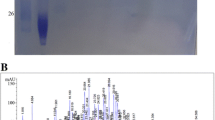Abstract
Almost completely homogenous gastric mucous epithelial cells of guinea pigs were grown to confluence in the presence of 10% fetal calf serum (FCS). FCS, epidermal growth factor (EGF), and insulin significantly increased 5-bromo-2′-deoxyuridine (BrdU) uptake by the cells and EGF together with insulin increased the cells' [3H] thymidine uptake. Basic fibroblast growth factor (bFGF) enhanced EGF-induced DNA synthesis by the cells, but vasoactive intestinal peptide (VIP), secretin, prostaglandin E2 (PGE2), and dibutyryl cyclic AMP (dbcAMP) neither induced DNA synthesis nor enhanced the effect of EGF on DNA synthesis by the cells. Gastrin, cholecystokinin-octapeptide (CCK8), and carbamylcholine chloride (CCh) also did not enhance the effect of EGF on DNA synthesis.125I-EGF,125I-bFGF, and125I-gastrin binding to the gastric mucous cells revealed the presence of high-affinity receptors for EGF and bFGF, but not for gastrin. Northern blot analysis showed the expression of EGF receptor mRNA, but not gastrin receptor mRNA. These results suggest that EGF, insulin, and bFGF may cooperatively regulate gastric mucous cell growth, but that gastrin and other gastrointestinal hormones do not have a direct stimulatory effect on mucous cell growth in the guinea pig.
Similar content being viewed by others
References
Johnson LR. New aspects of the trophic action of gastrointestinal hormones. Gastroenterology 1977;72:788–792.
Johnson LR, Aures D, Hakason R. Effect of gastrin on the in vitro incorporation of14C-leucine into protein of the digestive tract. Proc Soc Exp Biol Med 1969;132:996–998.
Miller LR, Jacobsen ED, Johnson LR. Effect of pentagastrin on gastric mucosal cells grown in tissue culture. Gastroenterology 1973;64:254–267.
Neuberger R, Lewin M, Bonfils S. Parietal and chief cell population in four cases of the Zollinger-Ellison syndrome. Gastroenterology 1972;63:937–942.
Seidel ER, Tabata K, Dembinski AB, et al. Attenuation of trophic response to gastrin after inhibition of ornithine decarboxylase. Am J Physiol 1985;249:G16-G20.
Majumdar APN, Edgerton EA, Dayal Y, et al. Gastrin: Levels and trophic action during advancing age. Am J Physiol 1988; 254:G538-G542.
Johnson LR, Guthrie AD. Stimulation of rat oxyntic gland mucosal growth by epidermal growth factor. Am J Physiol 1980;238:G45-G49.
Konturek SJ, Radecki T, Brozozowski T, et al. Gastric cytoprotection by epidermal growth factor. Gastroenterology 1981;81:438–443.
Konturek SJ, Dembinski A, Warzecha Z, et al. Role of epidermal growth factor in healing of chronic gastroduodenal ulcers in rats. Gastroenterology 1986;94:1300–1307.
Konturek PK, Brozozowski T, Konturek SJ, et al. Role of epidermal growth factor, prostaglandin and sulfhydryls in stress-induced gastric lesions. Gastroenterology 1990;99:1607–1615.
Folkman J, Szabo S, Stovroff M, et al. Duodenal ulcer: Discovery of a new mechanism and development of angiogenic therapy that accelerates healing. Ann Surg 1991;214:414–427.
Chen MC, Lee AT, Soll AH. Mitogenic response of canine fundic epithelial cells in short-term culture to transforming growth factor α and insulin-like growth factor 1. J Clin Invest 1991;87:1716–1723.
Rutten MJ, Dempsey PJ, Solomon TE, et al. TGFα is a potent mitogen for primary cultures of guinea pig gastric mucous epithelial cells. Am J Physiol 1993;265:G361-G369.
Maeda M, Oshima K, Tamura S, et al. Human gastric H+, K+-ATPase similarly to Na+, K+-ATPase genes in exon/intron organization but difference in control lesion. J Biol Chem 1990; 265:9027–9032.
Samloff IM. Cellular localization of group I pepsinogen in human gastric mucosa by immunofluorescence. Gastroenterology 1971; 61:185–188.
Marangos PJ, Schmechel D, Zis AP, et al. The existence and neurobiological significance of neuronal and glial forms of the glycolytic enzyme enolase. Biol Psychiatry 1979;14:563–579.
Gonchoroff NJ, Katzmann JA, Currie RM, et al. S-phase detection with an antibody to bromodeoxyuridine. J Immunol Methods 1986;93:97–101.
Hamlin J, Pardee AB. S phase synchrony in monolayer CHO cultures. Exp Cell Res 1976;100:265–275.
Xu Y, Ishii S, Clark AJL, et al. Human epidermal growth factor receptor cDNA is homologous to a variety of RNAs overproduced in A431 carcinoma cells. Nature 1984;309:806–810.
Terano A, Ivey KJ, Stachura J, et al. Cell culture of rat gastric fundic mucosa. Gastroenterology 1983;83:1280–1291.
Ota S, Terano A, Hiraishi H, et al. A monolayer culture of gastric mucous cells from adult rabbit. Gastroenterology 1990;25:1–7.
Lee H, Hansson HA, Norstrom E, et al. Immunoreactivities for epidermal growth factor (EGF) and for EGF receptors in rats with gastric ulcers. Cell Tissue Res 1991;265:211–218.
Beauchamp RD, Barhard JA, McCutchen CM, et al. Localization of transforming growth factor α and its receptor in gastric mucosal cells. J Clin Invest 1989;84:1017–1023.
Sakamoto C, Matsuda K, Nakano O, et al. EGF stimulates both cyclooxygenase activity and cell proliferation of cultured guinea pig gastric mucous cells. J Gastroenterol 1994;29:73–76.
Dignass AU, Tsunekawa S, Podolsky DK. Fibroblast growth factors modulate intestinal epithelial cell growth and migration. Gastroenterology 1994;106:1254–1262.
Paimela H, Goddard PJ, Carter K, et al. Restitution of frog gastric mucosa in vitro. Gastroenterology 1993;104:1337–1345.
Burgess WH, Maciag T. The heparin-binding (fibroblast) growth factor family of protein. Annu Rev Biochem 1989;58:575–606.
Moscatelli D. High and low affinity binding sites for basic fibroblast growth factor on cultured cells: Absence of a role for low affinity binding in the stimulation of plasminogen activator production by bovine capillary endothelial cells. J Cell Physiol 1987;131:123–130.
Matsuoka K, Fukami K, Nakanishi O, et al. Mitogenesis in response to PDGF and bombesin abolished by microinjection of antibody to PIP2. Science 1988;293:640–643.
Author information
Authors and Affiliations
Rights and permissions
About this article
Cite this article
Matsuda, K., Sakamoto, C., Konda, Y. et al. Effects of growth factors and gut hormones on proliferation of primary cultured gastric mucous cells of guinea pig. J Gastroenterol 31, 498–504 (1996). https://doi.org/10.1007/BF02355048
Received:
Accepted:
Issue Date:
DOI: https://doi.org/10.1007/BF02355048




